ENT1253: Strategic Healthcare Business Plan for Malaysia
VerifiedAdded on 2022/12/29
|6
|1598
|60
Report
AI Summary
This report details a business plan for a healthcare venture in Malaysia, specifically focusing on telehealth services to address the needs of people who cannot afford high healthcare costs, especially in rural areas. The report analyzes the current healthcare scenario, challenges, and the government's vision 2020, emphasizing the importance of telehealth to improve access to healthcare. The business plan includes an implementation strategy, addressing challenges such as integration issues and the need for qualified doctors. It proposes a membership-based telehealth service, offering affordable healthcare solutions and bridging the gap between primary and secondary healthcare systems. The report concludes that telehealth is a viable option to achieve equitable and accessible healthcare for all in Malaysia.
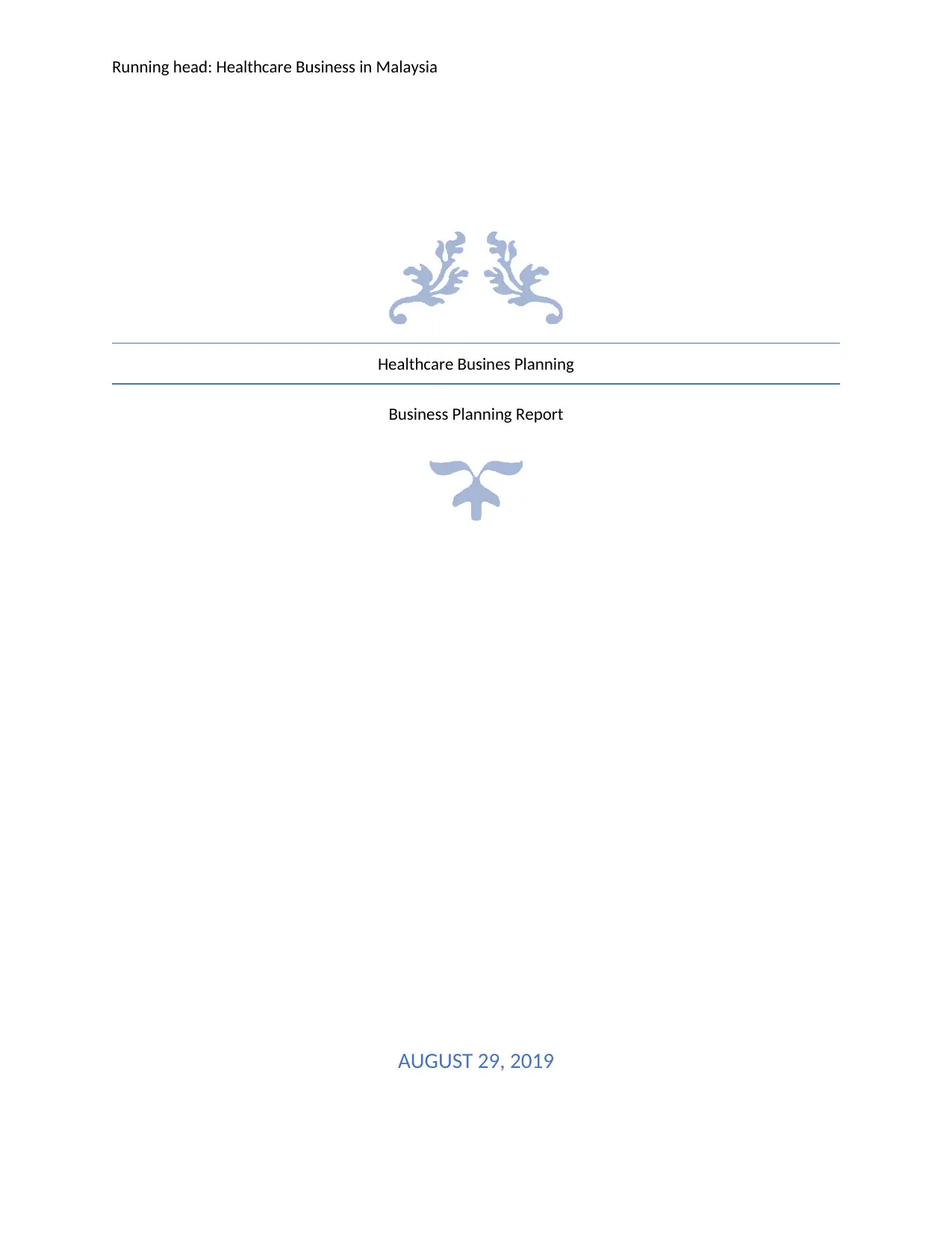
Running head: Healthcare Business in Malaysia
Healthcare Busines Planning
Business Planning Report
AUGUST 29, 2019
Healthcare Busines Planning
Business Planning Report
AUGUST 29, 2019
Paraphrase This Document
Need a fresh take? Get an instant paraphrase of this document with our AI Paraphraser
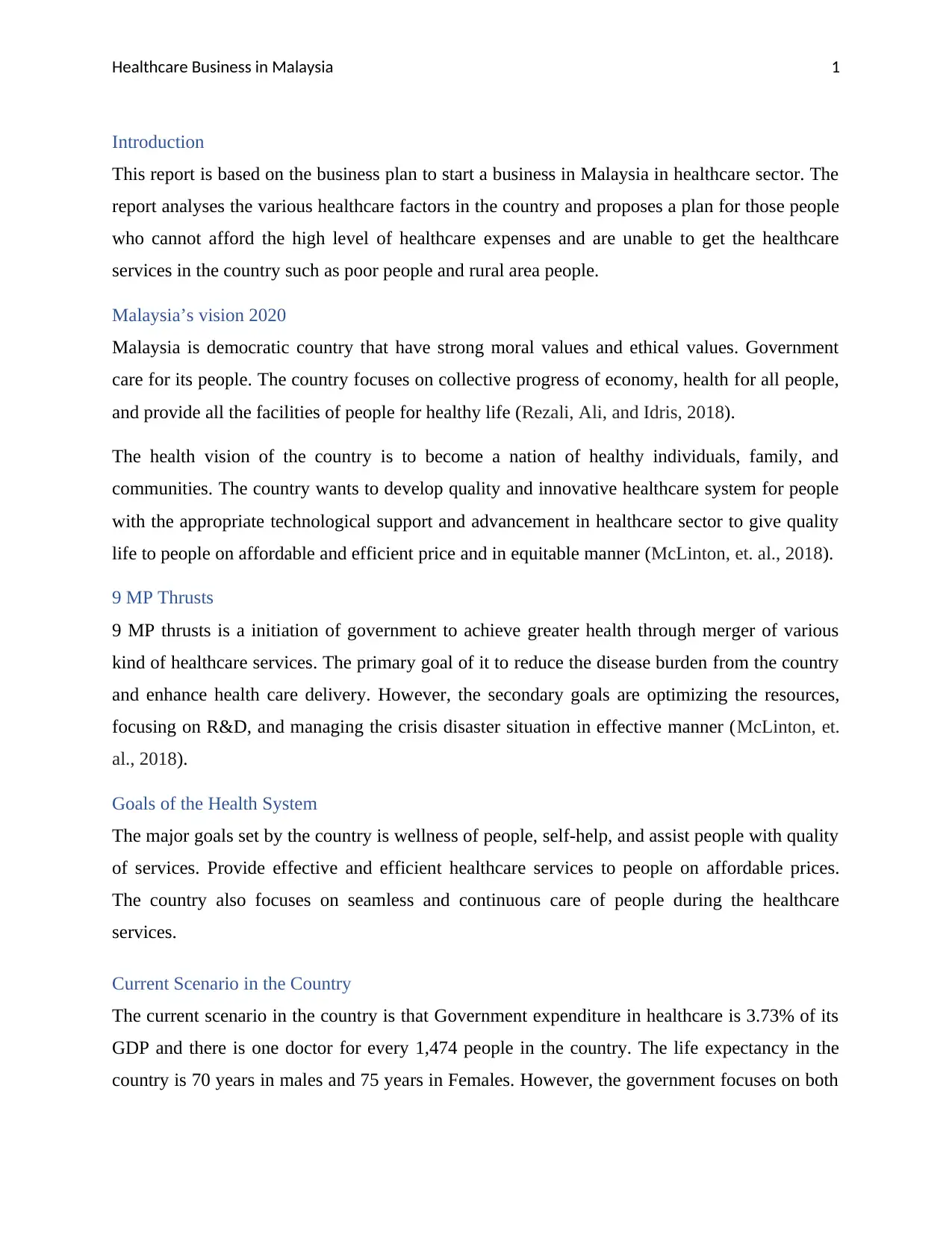
Healthcare Business in Malaysia 1
Introduction
This report is based on the business plan to start a business in Malaysia in healthcare sector. The
report analyses the various healthcare factors in the country and proposes a plan for those people
who cannot afford the high level of healthcare expenses and are unable to get the healthcare
services in the country such as poor people and rural area people.
Malaysia’s vision 2020
Malaysia is democratic country that have strong moral values and ethical values. Government
care for its people. The country focuses on collective progress of economy, health for all people,
and provide all the facilities of people for healthy life (Rezali, Ali, and Idris, 2018).
The health vision of the country is to become a nation of healthy individuals, family, and
communities. The country wants to develop quality and innovative healthcare system for people
with the appropriate technological support and advancement in healthcare sector to give quality
life to people on affordable and efficient price and in equitable manner (McLinton, et. al., 2018).
9 MP Thrusts
9 MP thrusts is a initiation of government to achieve greater health through merger of various
kind of healthcare services. The primary goal of it to reduce the disease burden from the country
and enhance health care delivery. However, the secondary goals are optimizing the resources,
focusing on R&D, and managing the crisis disaster situation in effective manner (McLinton, et.
al., 2018).
Goals of the Health System
The major goals set by the country is wellness of people, self-help, and assist people with quality
of services. Provide effective and efficient healthcare services to people on affordable prices.
The country also focuses on seamless and continuous care of people during the healthcare
services.
Current Scenario in the Country
The current scenario in the country is that Government expenditure in healthcare is 3.73% of its
GDP and there is one doctor for every 1,474 people in the country. The life expectancy in the
country is 70 years in males and 75 years in Females. However, the government focuses on both
Introduction
This report is based on the business plan to start a business in Malaysia in healthcare sector. The
report analyses the various healthcare factors in the country and proposes a plan for those people
who cannot afford the high level of healthcare expenses and are unable to get the healthcare
services in the country such as poor people and rural area people.
Malaysia’s vision 2020
Malaysia is democratic country that have strong moral values and ethical values. Government
care for its people. The country focuses on collective progress of economy, health for all people,
and provide all the facilities of people for healthy life (Rezali, Ali, and Idris, 2018).
The health vision of the country is to become a nation of healthy individuals, family, and
communities. The country wants to develop quality and innovative healthcare system for people
with the appropriate technological support and advancement in healthcare sector to give quality
life to people on affordable and efficient price and in equitable manner (McLinton, et. al., 2018).
9 MP Thrusts
9 MP thrusts is a initiation of government to achieve greater health through merger of various
kind of healthcare services. The primary goal of it to reduce the disease burden from the country
and enhance health care delivery. However, the secondary goals are optimizing the resources,
focusing on R&D, and managing the crisis disaster situation in effective manner (McLinton, et.
al., 2018).
Goals of the Health System
The major goals set by the country is wellness of people, self-help, and assist people with quality
of services. Provide effective and efficient healthcare services to people on affordable prices.
The country also focuses on seamless and continuous care of people during the healthcare
services.
Current Scenario in the Country
The current scenario in the country is that Government expenditure in healthcare is 3.73% of its
GDP and there is one doctor for every 1,474 people in the country. The life expectancy in the
country is 70 years in males and 75 years in Females. However, the government focuses on both
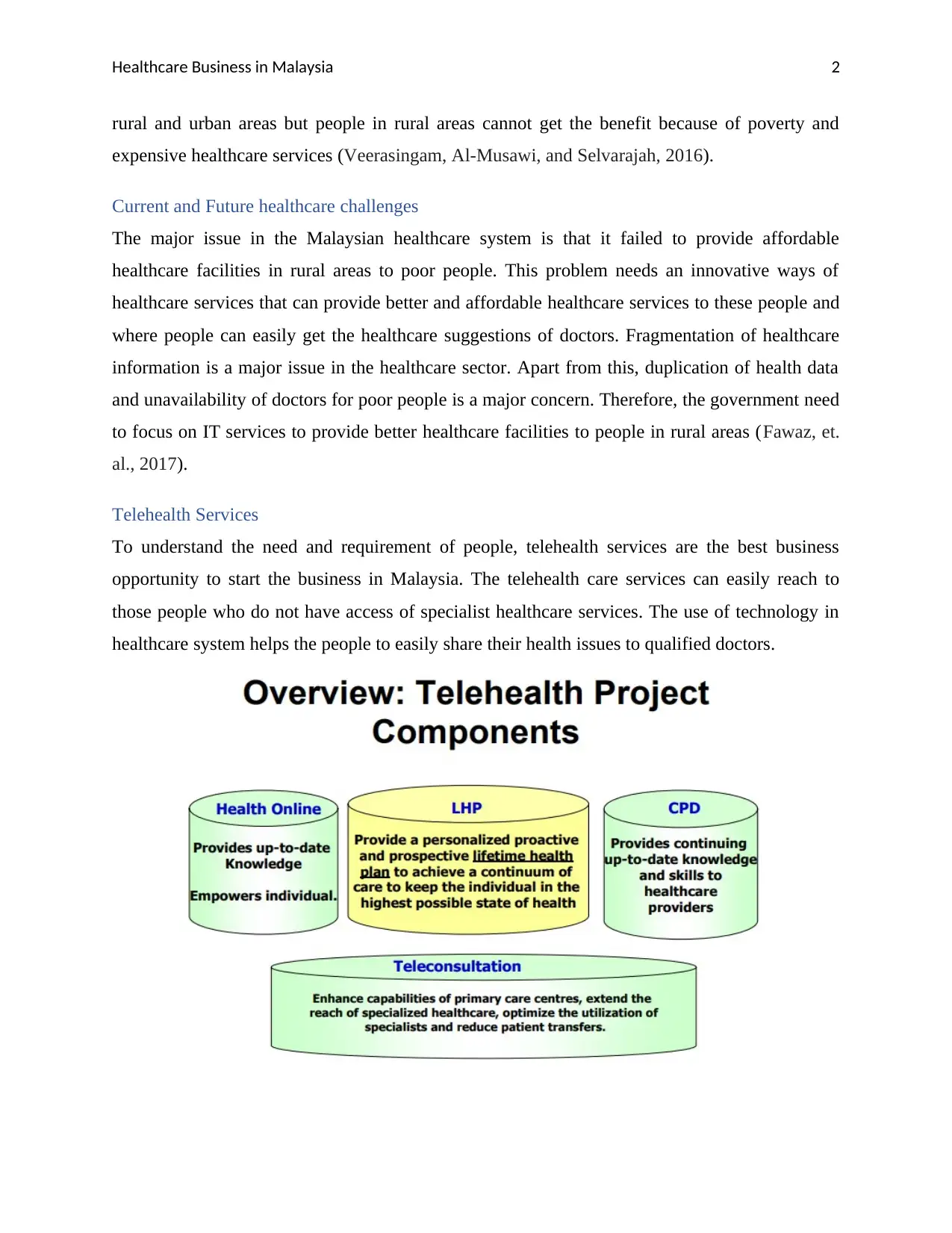
Healthcare Business in Malaysia 2
rural and urban areas but people in rural areas cannot get the benefit because of poverty and
expensive healthcare services (Veerasingam, Al-Musawi, and Selvarajah, 2016).
Current and Future healthcare challenges
The major issue in the Malaysian healthcare system is that it failed to provide affordable
healthcare facilities in rural areas to poor people. This problem needs an innovative ways of
healthcare services that can provide better and affordable healthcare services to these people and
where people can easily get the healthcare suggestions of doctors. Fragmentation of healthcare
information is a major issue in the healthcare sector. Apart from this, duplication of health data
and unavailability of doctors for poor people is a major concern. Therefore, the government need
to focus on IT services to provide better healthcare facilities to people in rural areas (Fawaz, et.
al., 2017).
Telehealth Services
To understand the need and requirement of people, telehealth services are the best business
opportunity to start the business in Malaysia. The telehealth care services can easily reach to
those people who do not have access of specialist healthcare services. The use of technology in
healthcare system helps the people to easily share their health issues to qualified doctors.
rural and urban areas but people in rural areas cannot get the benefit because of poverty and
expensive healthcare services (Veerasingam, Al-Musawi, and Selvarajah, 2016).
Current and Future healthcare challenges
The major issue in the Malaysian healthcare system is that it failed to provide affordable
healthcare facilities in rural areas to poor people. This problem needs an innovative ways of
healthcare services that can provide better and affordable healthcare services to these people and
where people can easily get the healthcare suggestions of doctors. Fragmentation of healthcare
information is a major issue in the healthcare sector. Apart from this, duplication of health data
and unavailability of doctors for poor people is a major concern. Therefore, the government need
to focus on IT services to provide better healthcare facilities to people in rural areas (Fawaz, et.
al., 2017).
Telehealth Services
To understand the need and requirement of people, telehealth services are the best business
opportunity to start the business in Malaysia. The telehealth care services can easily reach to
those people who do not have access of specialist healthcare services. The use of technology in
healthcare system helps the people to easily share their health issues to qualified doctors.
⊘ This is a preview!⊘
Do you want full access?
Subscribe today to unlock all pages.

Trusted by 1+ million students worldwide
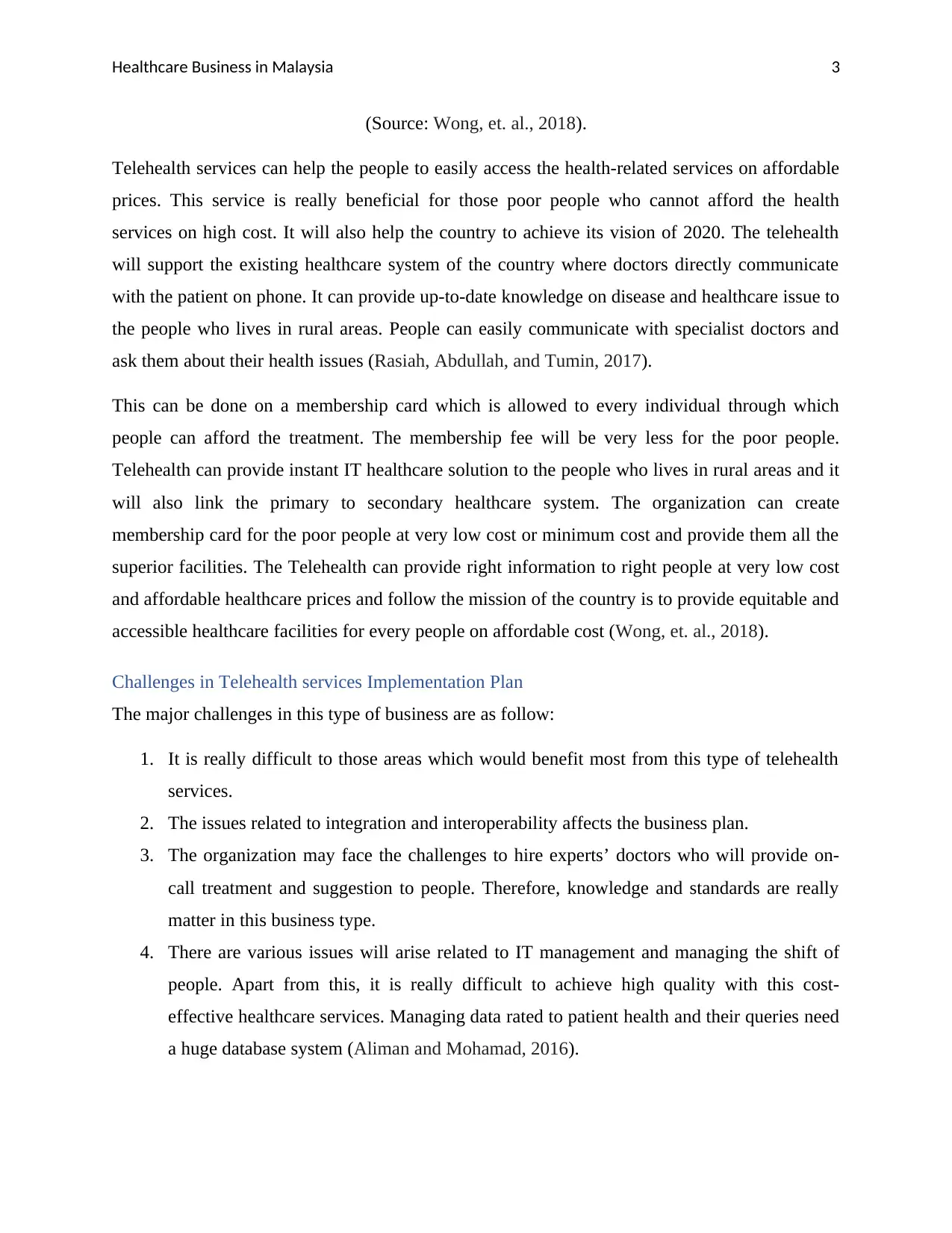
Healthcare Business in Malaysia 3
(Source: Wong, et. al., 2018).
Telehealth services can help the people to easily access the health-related services on affordable
prices. This service is really beneficial for those poor people who cannot afford the health
services on high cost. It will also help the country to achieve its vision of 2020. The telehealth
will support the existing healthcare system of the country where doctors directly communicate
with the patient on phone. It can provide up-to-date knowledge on disease and healthcare issue to
the people who lives in rural areas. People can easily communicate with specialist doctors and
ask them about their health issues (Rasiah, Abdullah, and Tumin, 2017).
This can be done on a membership card which is allowed to every individual through which
people can afford the treatment. The membership fee will be very less for the poor people.
Telehealth can provide instant IT healthcare solution to the people who lives in rural areas and it
will also link the primary to secondary healthcare system. The organization can create
membership card for the poor people at very low cost or minimum cost and provide them all the
superior facilities. The Telehealth can provide right information to right people at very low cost
and affordable healthcare prices and follow the mission of the country is to provide equitable and
accessible healthcare facilities for every people on affordable cost (Wong, et. al., 2018).
Challenges in Telehealth services Implementation Plan
The major challenges in this type of business are as follow:
1. It is really difficult to those areas which would benefit most from this type of telehealth
services.
2. The issues related to integration and interoperability affects the business plan.
3. The organization may face the challenges to hire experts’ doctors who will provide on-
call treatment and suggestion to people. Therefore, knowledge and standards are really
matter in this business type.
4. There are various issues will arise related to IT management and managing the shift of
people. Apart from this, it is really difficult to achieve high quality with this cost-
effective healthcare services. Managing data rated to patient health and their queries need
a huge database system (Aliman and Mohamad, 2016).
(Source: Wong, et. al., 2018).
Telehealth services can help the people to easily access the health-related services on affordable
prices. This service is really beneficial for those poor people who cannot afford the health
services on high cost. It will also help the country to achieve its vision of 2020. The telehealth
will support the existing healthcare system of the country where doctors directly communicate
with the patient on phone. It can provide up-to-date knowledge on disease and healthcare issue to
the people who lives in rural areas. People can easily communicate with specialist doctors and
ask them about their health issues (Rasiah, Abdullah, and Tumin, 2017).
This can be done on a membership card which is allowed to every individual through which
people can afford the treatment. The membership fee will be very less for the poor people.
Telehealth can provide instant IT healthcare solution to the people who lives in rural areas and it
will also link the primary to secondary healthcare system. The organization can create
membership card for the poor people at very low cost or minimum cost and provide them all the
superior facilities. The Telehealth can provide right information to right people at very low cost
and affordable healthcare prices and follow the mission of the country is to provide equitable and
accessible healthcare facilities for every people on affordable cost (Wong, et. al., 2018).
Challenges in Telehealth services Implementation Plan
The major challenges in this type of business are as follow:
1. It is really difficult to those areas which would benefit most from this type of telehealth
services.
2. The issues related to integration and interoperability affects the business plan.
3. The organization may face the challenges to hire experts’ doctors who will provide on-
call treatment and suggestion to people. Therefore, knowledge and standards are really
matter in this business type.
4. There are various issues will arise related to IT management and managing the shift of
people. Apart from this, it is really difficult to achieve high quality with this cost-
effective healthcare services. Managing data rated to patient health and their queries need
a huge database system (Aliman and Mohamad, 2016).
Paraphrase This Document
Need a fresh take? Get an instant paraphrase of this document with our AI Paraphraser
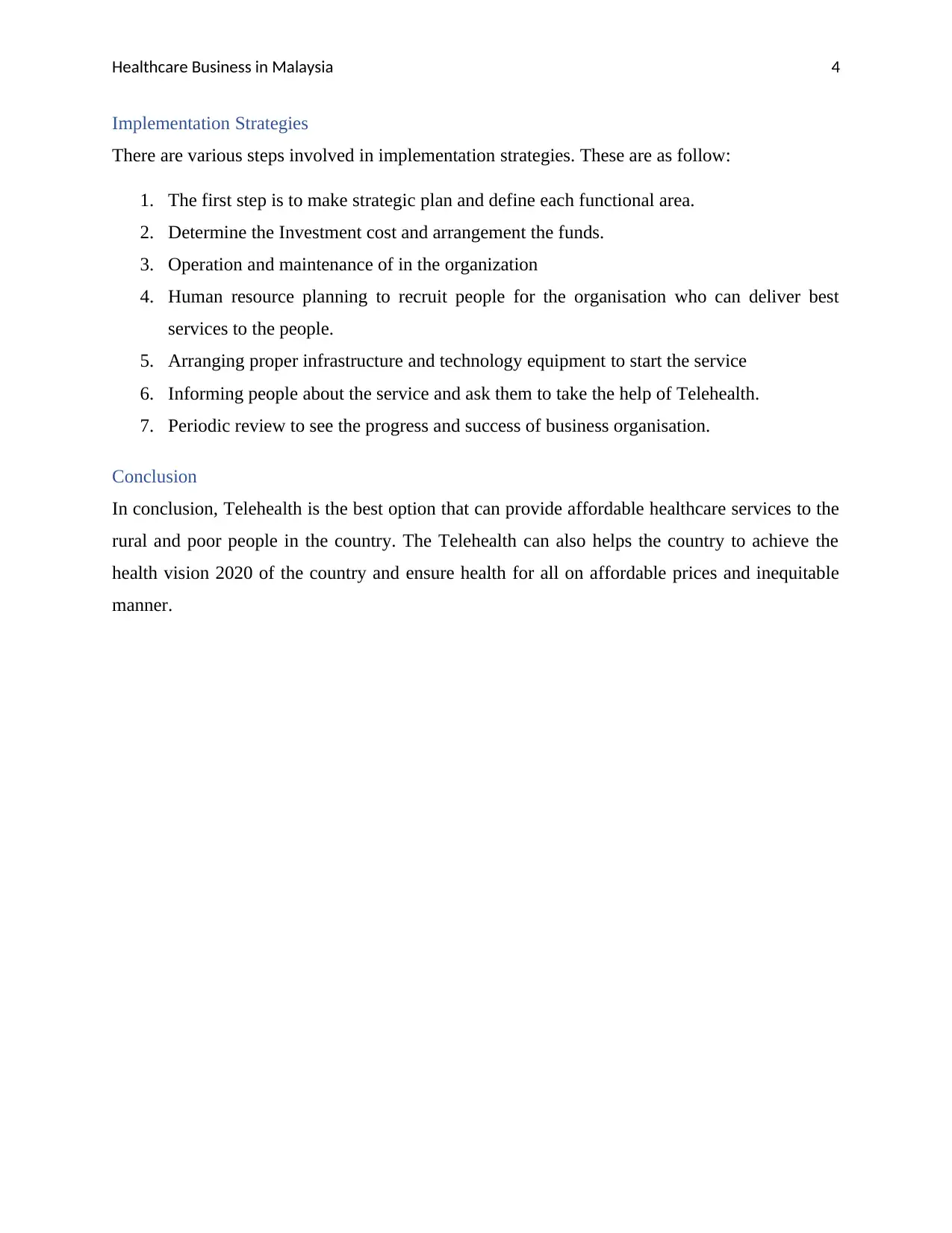
Healthcare Business in Malaysia 4
Implementation Strategies
There are various steps involved in implementation strategies. These are as follow:
1. The first step is to make strategic plan and define each functional area.
2. Determine the Investment cost and arrangement the funds.
3. Operation and maintenance of in the organization
4. Human resource planning to recruit people for the organisation who can deliver best
services to the people.
5. Arranging proper infrastructure and technology equipment to start the service
6. Informing people about the service and ask them to take the help of Telehealth.
7. Periodic review to see the progress and success of business organisation.
Conclusion
In conclusion, Telehealth is the best option that can provide affordable healthcare services to the
rural and poor people in the country. The Telehealth can also helps the country to achieve the
health vision 2020 of the country and ensure health for all on affordable prices and inequitable
manner.
Implementation Strategies
There are various steps involved in implementation strategies. These are as follow:
1. The first step is to make strategic plan and define each functional area.
2. Determine the Investment cost and arrangement the funds.
3. Operation and maintenance of in the organization
4. Human resource planning to recruit people for the organisation who can deliver best
services to the people.
5. Arranging proper infrastructure and technology equipment to start the service
6. Informing people about the service and ask them to take the help of Telehealth.
7. Periodic review to see the progress and success of business organisation.
Conclusion
In conclusion, Telehealth is the best option that can provide affordable healthcare services to the
rural and poor people in the country. The Telehealth can also helps the country to achieve the
health vision 2020 of the country and ensure health for all on affordable prices and inequitable
manner.
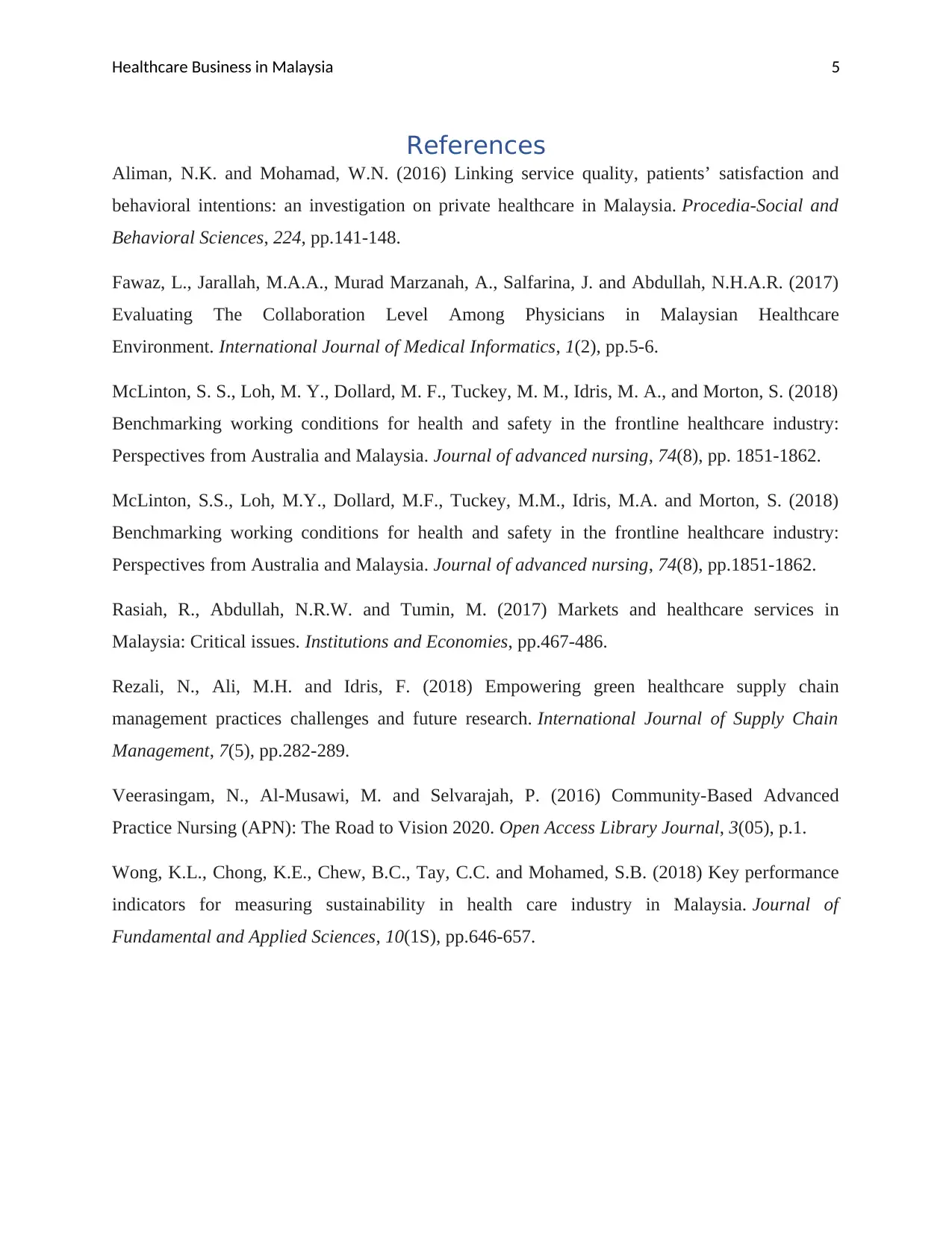
Healthcare Business in Malaysia 5
References
Aliman, N.K. and Mohamad, W.N. (2016) Linking service quality, patients’ satisfaction and
behavioral intentions: an investigation on private healthcare in Malaysia. Procedia-Social and
Behavioral Sciences, 224, pp.141-148.
Fawaz, L., Jarallah, M.A.A., Murad Marzanah, A., Salfarina, J. and Abdullah, N.H.A.R. (2017)
Evaluating The Collaboration Level Among Physicians in Malaysian Healthcare
Environment. International Journal of Medical Informatics, 1(2), pp.5-6.
McLinton, S. S., Loh, M. Y., Dollard, M. F., Tuckey, M. M., Idris, M. A., and Morton, S. (2018)
Benchmarking working conditions for health and safety in the frontline healthcare industry:
Perspectives from Australia and Malaysia. Journal of advanced nursing, 74(8), pp. 1851-1862.
McLinton, S.S., Loh, M.Y., Dollard, M.F., Tuckey, M.M., Idris, M.A. and Morton, S. (2018)
Benchmarking working conditions for health and safety in the frontline healthcare industry:
Perspectives from Australia and Malaysia. Journal of advanced nursing, 74(8), pp.1851-1862.
Rasiah, R., Abdullah, N.R.W. and Tumin, M. (2017) Markets and healthcare services in
Malaysia: Critical issues. Institutions and Economies, pp.467-486.
Rezali, N., Ali, M.H. and Idris, F. (2018) Empowering green healthcare supply chain
management practices challenges and future research. International Journal of Supply Chain
Management, 7(5), pp.282-289.
Veerasingam, N., Al-Musawi, M. and Selvarajah, P. (2016) Community-Based Advanced
Practice Nursing (APN): The Road to Vision 2020. Open Access Library Journal, 3(05), p.1.
Wong, K.L., Chong, K.E., Chew, B.C., Tay, C.C. and Mohamed, S.B. (2018) Key performance
indicators for measuring sustainability in health care industry in Malaysia. Journal of
Fundamental and Applied Sciences, 10(1S), pp.646-657.
References
Aliman, N.K. and Mohamad, W.N. (2016) Linking service quality, patients’ satisfaction and
behavioral intentions: an investigation on private healthcare in Malaysia. Procedia-Social and
Behavioral Sciences, 224, pp.141-148.
Fawaz, L., Jarallah, M.A.A., Murad Marzanah, A., Salfarina, J. and Abdullah, N.H.A.R. (2017)
Evaluating The Collaboration Level Among Physicians in Malaysian Healthcare
Environment. International Journal of Medical Informatics, 1(2), pp.5-6.
McLinton, S. S., Loh, M. Y., Dollard, M. F., Tuckey, M. M., Idris, M. A., and Morton, S. (2018)
Benchmarking working conditions for health and safety in the frontline healthcare industry:
Perspectives from Australia and Malaysia. Journal of advanced nursing, 74(8), pp. 1851-1862.
McLinton, S.S., Loh, M.Y., Dollard, M.F., Tuckey, M.M., Idris, M.A. and Morton, S. (2018)
Benchmarking working conditions for health and safety in the frontline healthcare industry:
Perspectives from Australia and Malaysia. Journal of advanced nursing, 74(8), pp.1851-1862.
Rasiah, R., Abdullah, N.R.W. and Tumin, M. (2017) Markets and healthcare services in
Malaysia: Critical issues. Institutions and Economies, pp.467-486.
Rezali, N., Ali, M.H. and Idris, F. (2018) Empowering green healthcare supply chain
management practices challenges and future research. International Journal of Supply Chain
Management, 7(5), pp.282-289.
Veerasingam, N., Al-Musawi, M. and Selvarajah, P. (2016) Community-Based Advanced
Practice Nursing (APN): The Road to Vision 2020. Open Access Library Journal, 3(05), p.1.
Wong, K.L., Chong, K.E., Chew, B.C., Tay, C.C. and Mohamed, S.B. (2018) Key performance
indicators for measuring sustainability in health care industry in Malaysia. Journal of
Fundamental and Applied Sciences, 10(1S), pp.646-657.
⊘ This is a preview!⊘
Do you want full access?
Subscribe today to unlock all pages.

Trusted by 1+ million students worldwide
1 out of 6
Related Documents
Your All-in-One AI-Powered Toolkit for Academic Success.
+13062052269
info@desklib.com
Available 24*7 on WhatsApp / Email
![[object Object]](/_next/static/media/star-bottom.7253800d.svg)
Unlock your academic potential
Copyright © 2020–2025 A2Z Services. All Rights Reserved. Developed and managed by ZUCOL.





